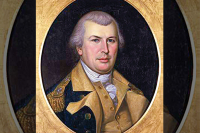Rutabagas and history of Hemphill Bald
Let us consider the relationship between grassy balds, Tom Alexander and the self-proclaimed “Potato and Rutabaga King of Haywood County.”
Highland sites at about 5,000 feet of elevation in the Smokies region were often given over to potato farming — and rutabagas, too. An example would be Hemphill Bald, where the Cataloochee Ranch resort, riding stables, and ski slope are located above Maggie Valley and adjacent to the Great Smoky Mountains National Park.
Most visitors assume that these grassy meadows are a part of the naturally occurring complex of somewhat similar areas known as grassy balds. Found in the Southern Blue Ridge Province from Virginia into Georgia, grassy balds are a mysterious habitat. More ink has been spilt regarding their origins than about any other natural area in the southern mountains.
The word “bald” has several meanings, of course, but when applied to terrain it refers to the lack of “usual or natural covering”; that is, in this instance, to a virtual absence of trees where trees might otherwise be expected. There are two types of balds in the Blue Ridge: (1) grassy balds and (2) shrub or heath balds. In a true grassy bald, the terrain is primarily open, being dominated by mountain oat grass and other herbaceous species.
I suspect that at least some of the initial grassy openings were forged during the Pleistocene Epoch 20,000 or so years ago when dramatic freeze-thaw intervals involving frost heaving and soil erosion occurred. These openings were expanded and maintained by wind, dryness, cold, fire (natural and manmade, starting with the earliest Indians who penetrated the region), and grazing (by settlers’ livestock, as well as by the herds of elk, caribou, and additional grazing animals that once populated the region).
Whatever their origin, these lovely natural areas are apparently not being created at the present time; in fact, those on public lands now being “protected” from fire and grazing are increasingly being invaded by shrubs and trees. They are literally disappearing in our own time.
Related Items
My guess is that the potato (and rutabaga) farms established at Gooseberry Knob and Hemphill Bald in the late 19th and early 20th centuries were found — in part at least -— where natural grassy balds had existed. It’s difficult to imagine someone venturing into what would otherwise have been a high-elevation, chestnut-dominated forest and establishing such grassy expanses without the benefit of some initial open areas. It’s possible, I suppose, but it doesn’t seem likely.
This leads us to the fellow who had the gumption to establish a vast potato (and rutabaga) empire at more than 5,000 feet along the Cataloochee Divide. His name was Verlin Campbell. He is best described by Tom Alexander Sr., in a delightful book titled Mountain Fever (Asheville: Bright Mountain Books, 1995). Tom Alexander (Mr. Tom) was the founder, along with his wife, Judy, of Cataloochee Ranch in the late 1930s. Mr. Tom died in 1972. His book was edited posthumously by his son and daughter-in law, Tom Jr. and Jane Alexander.
Mr. Tom purchased the initial Cataloochee Ranch properties from Campbell. Here are some excerpts from his description of the self-proclaimed “Potato and Rutabaga King of Haywood County.” His first encounter with Campbell was while driving up the road (if you could call it that) from Maggie Valley (where the Ghost Town parking lot is now located) to the Fie Top and Hemphill Bald areas.
“Halfway up ... I overtook a Ford roadster which had stopped to cool off and water up. The occupants turned out to be Verlin Campbell, owner of Fie Top, and his son, Kyle, who lived in town and was driving his father home.
“Verlin was a huge man, with a face reminiscent of the cartoon character Alley Oop and a voice that boomed across the gorge beside us and rolled off the ridges .... No sooner than I made myself known to this enormous man than he exploded with a startling greeting: ‘Yo’re just the man I’m alooking fer! I’ve got the finest tourist place up here in the world! I want you to see hit!”
After visiting the Campbell’s picturesque residence, Mr. Tom was taken on a tour of the area, including Ned’s Lick, a site where cows were provided salt.
“Ned’s Lick was named for their former owner, Ned Moody, from whom Verlin had acquired the property. Here was a stretch of open land blanketing the gap in the ridge and lapping down into the coves on both sides. About five acres were in beans. The rest of the forty or fifty acres of clearing was in grass except for three scattered one- or two-acre patches of potatoes and a patch of oats. The dirt was black and there were no gullies ... Verlin told me that one year he had raised 935 bushels of produce — potatoes and rutabagas — on one measure acre on top of the knoll. At the time I discounted this statement. Later after learning what that wonderful soil can do, I no longer doubt it.
“Verlin’s agricultural plan was to plow up new patches of grassland each year for his potatoes, then reseed the following spring in meadow grasses and oats. His method of planting was unorthodox. Instead of preparing his ground by plowing, harrowing, and pulverizing before putting in his seeds, he planted as he plowed ... The result was an exceedingly rough-planted hillside field, with great chunks of turf standing on edge or leaning half over. But the turf caught and held the rain, preventing runoff on those steep slopes ... Verlin relied on two-crop farming. On the last, or `lay-by’ working, tender little rutabaga plants were set out by hand between the potato rows .... When the plants were large enough, they were thinned to a stand eight to sixteen inches apart, and the surplus was then set out in additional rows.”
Campbell’s unorthodox planting methods, one might note, also maintained (albeit in a limited fashion) the grassy nature of the setting. Had he not planted in this manner very little, if any, grassland could have been maintained on such a steep slope. So, in part at least, if you connect the dots, it could be argued that potatoes and rutabagas preserved the “essence” of a natural setting created many thousands of years old.
George Ellison wrote the biographical introductions for the reissues of two Appalachian classics: Horace Kephart’s Our Southern Highlanders and James Mooney’s History, Myths, and Sacred Formulas of the Cherokees. In June 2005, a selection of his Back Then columns was published by The History Press in Charleston as Mountain Passages: Natural and Cultural History of Western North Carolina and the Great Smoky Mountains. Readers can contact him at P.O. Box 1262, Bryson City, N.C., 28713, or at This email address is being protected from spambots. You need JavaScript enabled to view it..









